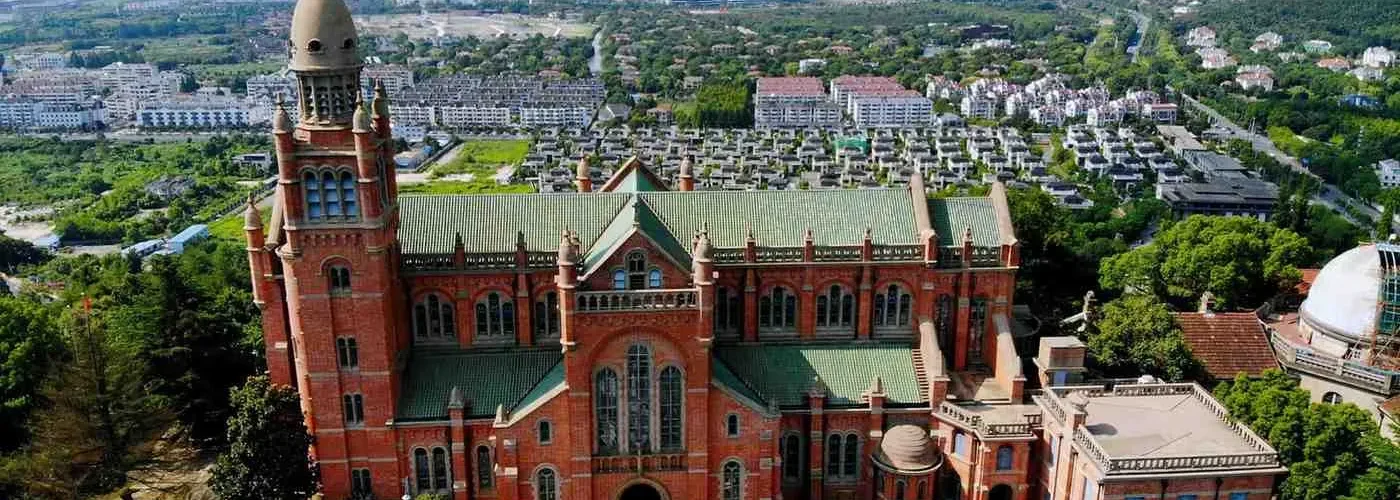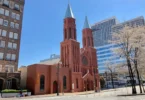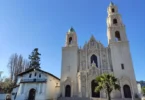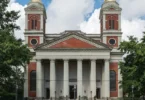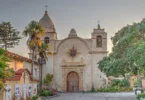Introduction
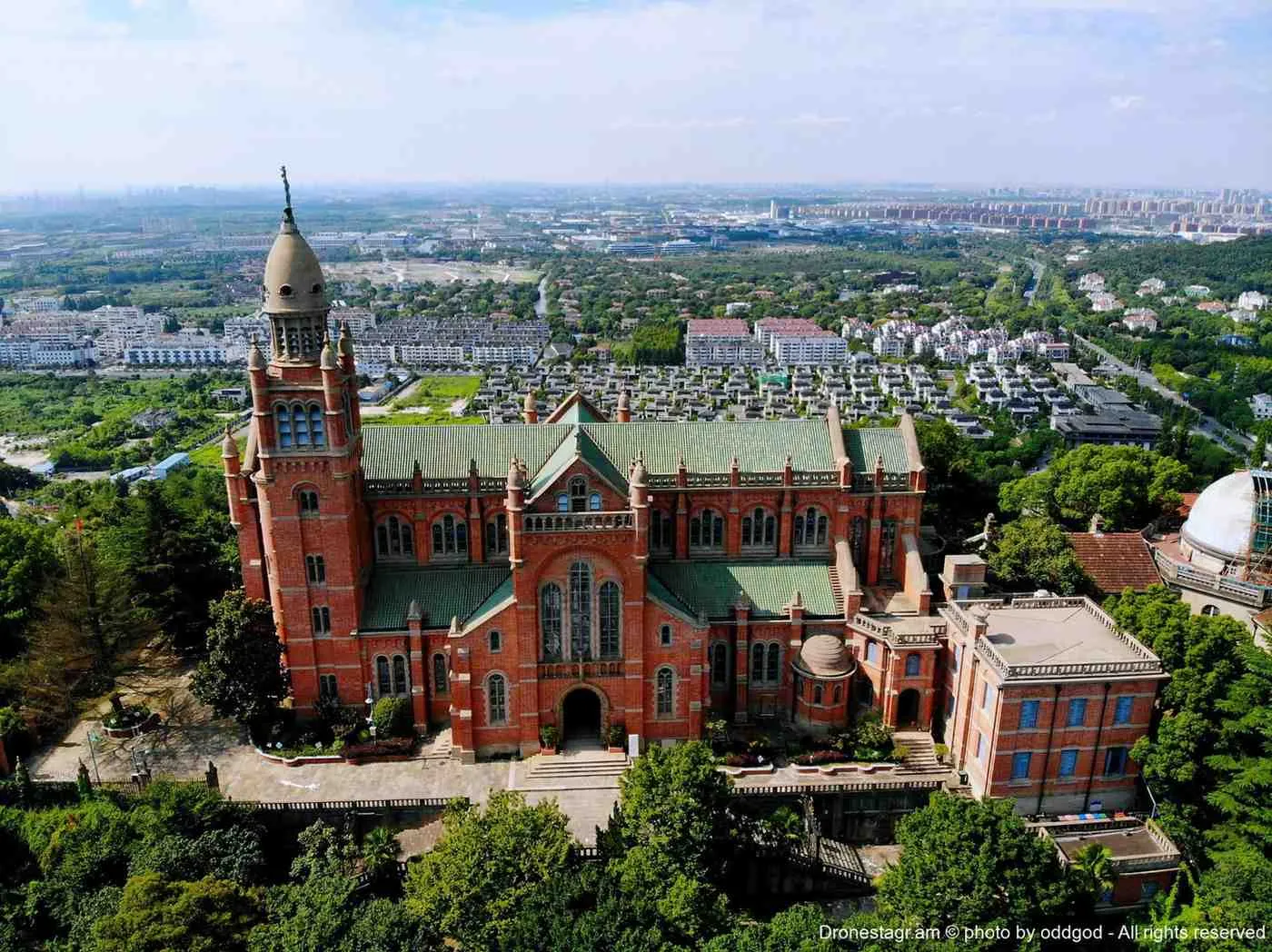
The Sheshan Basilica of Our Lady Help of Christians, also known as the National Shrine of Our Mother of Sheshan, is a prominent Catholic church located atop Sheshan Mountain in the Songjiang District of Shanghai, China. This awe-inspiring basilica holds great significance as both a spiritual center and a pilgrimage destination for Catholics in China, particularly as a Marian site. The basilica is officially recognized as a Class B Catholic basilica, highlighting its importance within the Roman Catholic Church in China. The shrine’s name derives from its location on Sheshan Hill, a scenic area to the west of Shanghai’s urban center, nestled in the Songjiang District. The church is dedicated to the veneration of the Blessed Virgin Mary, specifically under the title of Mary Help of Christians (Latin: Nostra Domina Mariæ Auxiliatricis Christianorum), making it a place of deep religious reverence and devotion. The basilica’s history dates back to its elevation to the status of a Minor Basilica by Pope Pius XII on September 12, 1942, through his Pontifical decree Compertum Habemus. This decision officially recognized the spiritual and historical importance of the site, further cementing the church’s place in Catholic tradition. The original romanized name for the basilica, “Zosé Basilica,” was derived from the Shanghainese pronunciation of the Chinese characters “佘山” (Sheshan).
At the heart of the basilica is the revered statue of Our Lady Help of Christians, which has become a powerful symbol of protection and intercession for the faithful. In addition to this venerated image, the icon of Our Mother of Sheshan—recently reconstructed—also draws deep devotion from Chinese Catholics. These icons serve as powerful reminders of faith and devotion, making the basilica a key site for prayer and reflection for Catholics not just from Shanghai, but from all across China. Today, the Sheshan Basilica remains a significant Marian pilgrimage destination, attracting both local worshippers and international visitors who seek spiritual solace, healing, and connection with the divine. Its historical and cultural significance, coupled with its striking location atop Sheshan Mountain, makes it one of the most important Catholic shrines in China and a testament to the enduring presence of Catholicism in the region.
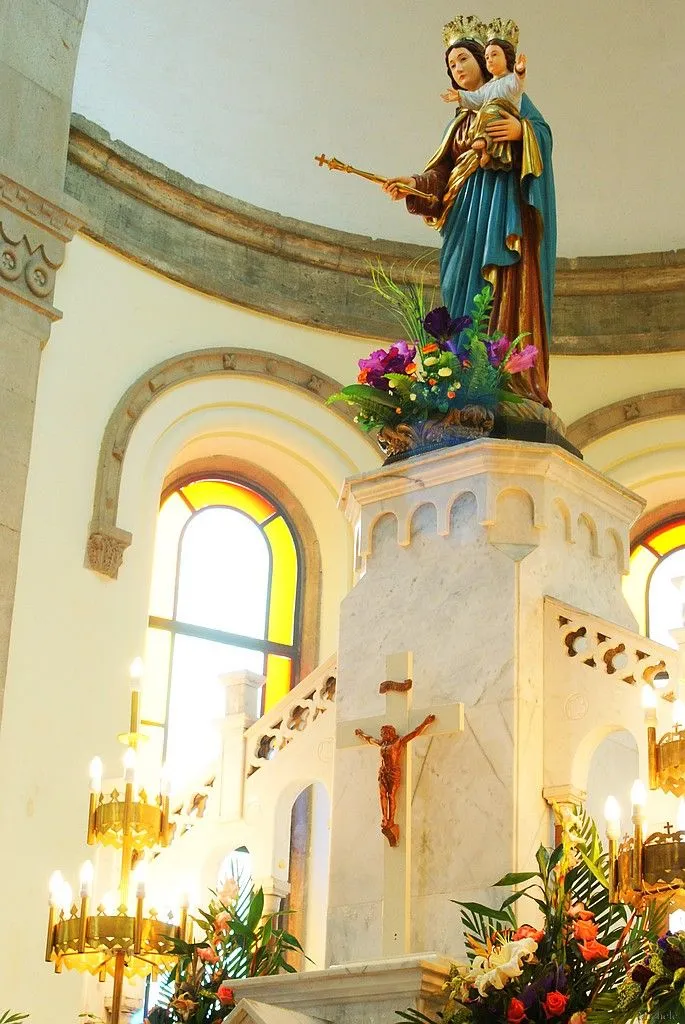
Catholicism was introduced to the region of Songjiang and Qingpu, near Sheshan, very early in China’s Christian history. During the period of religious prohibition, which lasted for over a century, Catholics in villages like Hengtang and Zhangpuqiao kept their faith alive in secret. In 1844, after the legalization of Catholicism in China, French Jesuit Nan Gelu, the president of the Jiangnan Vicariate, traveled to Sheshan. He was struck by the mountain’s quiet and peaceful environment, with its bamboo forests, and believed it would be an ideal location for building a prayer house for the elderly and ailing missionaries in the area. Nan Gelu passed away in 1856, but his vision was carried forward by subsequent leaders.
In 1863, Nan Gelu’s successor, Father Orbi, came to Sheshan from Xujiahui and constructed five bungalows halfway up the mountain for priests to recuperate. These bungalows also housed a small chapel. In 1864, Father Du Ruolan, the archdeacon of Songjiang, built a hexagonal pavilion on the mountain’s peak to enshrine a statue of the Virgin Mary. It was around this time that Christians from surrounding areas began making pilgrimages to Sheshan.
The Consecration and Establishment of Sheshan’s Sanctuary
On March 1, 1868, Bishop Lang Huairen of the Jiangnan Vicariate consecrated the chapel and the statue of the Virgin Mary. The statue, painted by the Chinese auxiliary monk Lu Shengsan, was modeled after the “Our Lady of Victory” statue in Paris and was renamed “Our Lady Help of Christians.” On May 24, 1868, the Feast of Our Lady Help of Christians, hundreds of pilgrims visited Sheshan, but the small chapel could not accommodate the large crowd. As a result, a tent was set up to hold the Mass.
The Building of the Cathedral
In 1868, religious tensions escalated in neighboring provinces, such as Anhui and Jiangsu, where churches were attacked, and anti-foreign sentiments were on the rise. In response, Father Gu Zhensheng, president of the Jesuit Vicariate of Jiangnan, sought divine protection for the church. He knelt before the statue of the Virgin Mary in the pavilion and promised that, if the Jiangnan Vicariate could survive the crisis, a grand cathedral would be built in gratitude. After the crisis subsided, Father Gu called on the local parishes to raise funds for the cathedral’s construction.
The Sheshan Cathedral was designed by French Jesuit Brother Léon Mariot. The construction of the cathedral began with the laying of the foundation stone on May 24, 1871, the Feast of Our Lady Help of Christians. The event was attended by 6,000 believers. Volunteers carried heavy materials up the mountain to the construction site. By April 15, 1873, the Greek-style church at the top of the mountain was completed, and Bishop Lang Huairen consecrated the building. A Via Dolorosa, consisting of 14 pavilions, was also built along the winding path to the church. The pilgrimage to Sheshan grew in popularity, with 10,000 to 15,000 pilgrims attending Mass in May of 1873, and May became known as the first Marian month in Sheshan’s history.
Further Developments and Renovations
In 1894, the Zhongshan Our Lady Church was rebuilt in a traditional Chinese style, accommodating over 500 people. A couplet was inscribed at the entrance, emphasizing the sacredness of the pilgrimage site. A large open square was added in front of the church, allowing thousands of pilgrims to gather. The three saints’ pavilions were also erected on the west side of the church, dedicated to the Sacred Heart of Jesus, the Virgin Mary, and St. Joseph. The church was rebuilt again in 1925, with construction continuing until 1935. The project was overseen by Portuguese Jesuit Father Ye Zhaochang, and Bishop Yao Zongli laid the foundation. The church was built with strict attention to quality, as materials were carefully selected, and construction was supervised to meet high standards.
Recognition and Coronation by the Vatican
In 1942, during the War of Resistance against Japanese Aggression, Pope Pius XII canonized Sheshan Cathedral as a minor basilica, making it the first basilica in the Far East to be recognized by the Pope. In 1946, Sheshan received another honor when the Holy See allowed for the coronation of the statue of Our Lady of Sheshan, with Archbishop Yu Bin of Nanjing and Bishop Hui Jiliang of Shanghai leading the ceremony. Over 10,000 Catholics attended, and the statue was crowned in a deeply significant event. On May 18, 1947, the new Vatican ambassador to China, Pierre de Coronet, participated in a rededication ceremony, reciting the “Prayer of China to Our Lady.”
Destruction During the Cultural Revolution
The Cultural Revolution, which began in 1966, led to significant destruction of religious sites across China. Sheshan Cathedral was severely damaged during this period. The bronze statue of the Virgin Mary holding the baby Jesus, the stained glass windows, the Fourteen Stations of the Cross along the Via Dolorosa, and many other religious icons were destroyed as part of the government’s campaign against the “Four Olds” (old customs, culture, habits, and ideas).
Restoration and Recovery
After the Cultural Revolution, religious activities began to resume in China. In 1981, Sheshan Catholic Church was officially returned to the Shanghai Diocese. A Mass was held in the church with 5,000 attendees. Renovations began shortly afterward and were completed by 1984, with the consecration ceremony taking place in 1985. However, the original statue of the Virgin Mary had been lost during the Cultural Revolution, and a temporary iron cross was installed at the top of the bell tower. In 2000, the bronze statue of the Virgin Mary holding the Baby Jesus was restored, thanks to donations from the faithful. In 1982, Sheshan Monastery was established at the southern foot of the mountain to train Catholic clergy. The monks set up a service office to help pilgrims, explaining doctrine and teaching hymns during the annual pilgrimage in May.
Sheshan in the Modern Era
In December 2024, Bishop Shen Bin presided over the opening mass for the 2025 Jubilee Year at Xujiahui Catholic Church. During this ceremony, Sheshan was included as one of the six major pilgrimage sites of the Shanghai Diocese. This further solidified Sheshan’s importance as a destination for Catholic pilgrims.
Architecture of Basilica of Our Lady of Help of Christians at Sheshan,Shanghai, China
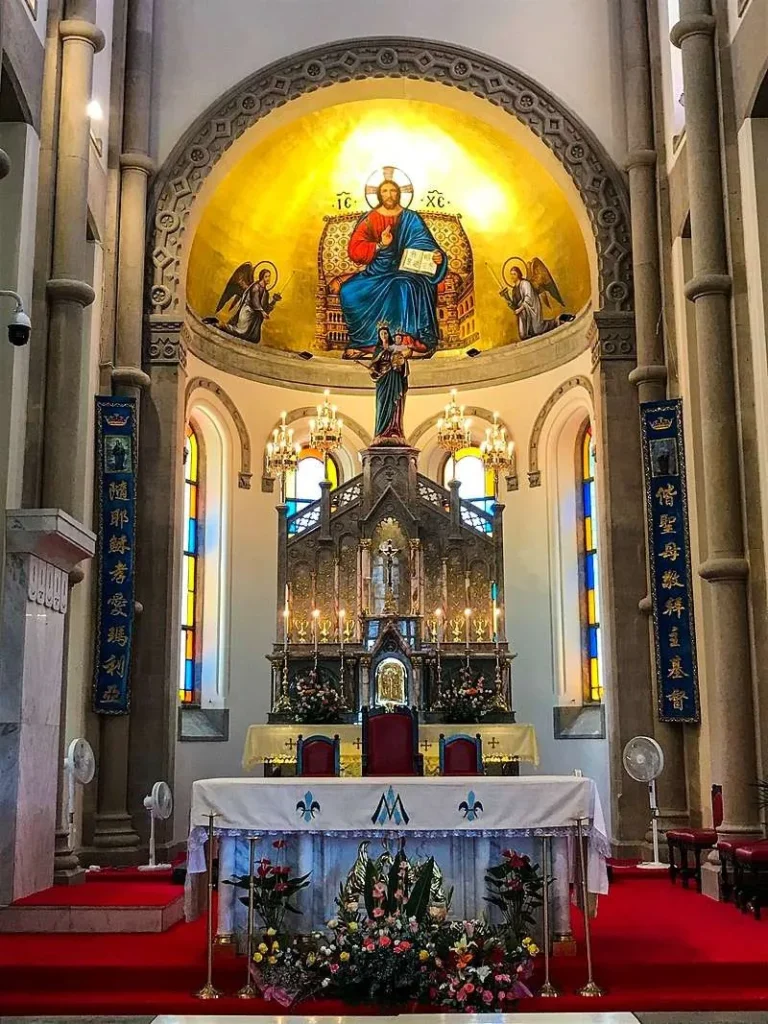
Architectural Style: Romanesque Architecture.
Internal Structure
Sheshan Cathedral, completed in 1935, is a Romanesque-style church located at the summit of Sheshan Mountain in China. The cathedral boasts a Latin cross-shaped floor plan, with dimensions measuring 56 meters in length from east to west and 25 meters in width from north to south, expanding to 35 meters at its widest point. Its exterior is constructed from red brick, and the main entrance is positioned on the southwest side. The church features a square bell tower at the southwest corner, rising to a height of 38 meters. At the top of the tower is an olive-shaped dome, supported by 16 pillars. Above the dome stands a 4.8-meter-high bronze statue of Our Lady of Christians, holding the baby Jesus, weighing 1.8 tons. The cathedral’s façade is adorned with pointed arched stained glass windows, framed by red brick walls. The roof is covered in emerald green glazed tiles, adding to its striking appearance. Inside, the cathedral offers seating for 3,000 worshippers. At the eastern end of the nave stands a grand altar, carved from marble and inlaid with gold and jade. A low white marble railing separates the altar from the hall, and the floor is paved with intricate flower-patterned tiles, enhancing the church’s elegance.
Construction Challenges
The construction of Sheshan Cathedral was a monumental task, especially considering the location atop Sheshan Mountain, which stands 98 meters above sea level. The transportation of materials posed significant challenges, with stones being shipped from Fujian by boat and carried up the mountain to the site. The cathedral’s structure is notable for its “four no’s” – it was built without nails, wood, steel, or beams, making it a unique feat of engineering.
Pilgrimage to Sheshan Cathedral
Traditional Pilgrimage Activities
Sheshan Cathedral has become an important pilgrimage site for Catholics, particularly during the month of May. Every year, tens of thousands of Catholics from across China travel to Sheshan to take part in the pilgrimage, which has become an enduring tradition. Pilgrims follow a fixed path: they begin by visiting the Zhongshan Hall to chant and pray, venerating the Mother of Sheshan and offering their devotion to the Mother of God. They then proceed along the Via Dolorosa on Jingzhe Road, following the Stations of the Cross. Afterward, they attend mass at the main hall and ask for mercy from the Mother of God. The pilgrimage concludes with prayers at the “Three Saints Pavilion.” Historically, many of the pilgrims were fishermen from the Jiangnan region. As a result, it was common for them to row their boats to the base of Sheshan Mountain before ascending to the church for the pilgrimage. The tradition of arriving by boat is still observed by many, and during May, the rivers near Sheshan are often filled with small boats carrying these devout believers.
Access to Sheshan and Pilgrimage Procedures
As part of the Shanghai Sheshan National Forest Park, the mountain where the cathedral stands is a popular tourist destination. Visitors must purchase tickets to enter the park through the main gates (East, North, or West), while pilgrims use a dedicated gate for access. However, with the free opening of Xishe Mountain Park, this restriction will eventually be lifted, allowing pilgrims and tourists to enter without the need for tickets.
Layout of Sheshan Cathedral
Sheshan Cathedral is situated on a 1-hectare site and stands about 20 meters tall. The church’s design is a rectangular Latin cross, in line with the classical basilica style. It has entrances on the north, west, and south sides, with the primary entrance located in the southwest corner. The interior nave measures 55.81 meters in length and 24.68 meters in width, with a ceiling height of 16.46 meters. The church can accommodate up to 3,000 people. The altar, located at the eastern end, is made of marble and features gold trim and inlaid jade. The exterior of the cathedral is primarily constructed from granite, with parts of the roof covered in traditional Chinese color-glazed tiles, adding a distinct cultural touch to the overall design.
Bell Tower and Statue
The cathedral’s bell tower, situated at the southeast corner, rises 38 meters in height. Atop the tower stands the 4.8-meter bronze statue of Our Lady of Zosé, also known as the Madonna and Child. This statue, a prominent feature of the church, symbolizes the devotion of the faithful and serves as a beacon for pilgrims arriving from far and wide.
Other Notable Features
Along the steep zig-zag paths leading up to the church, pilgrims can find the Stations of the Cross. At the midpoint of the ascent, an open square features two shrines – one dedicated to the Sacred Heart and the other to the Virgin Mary, offering a place for reflection and prayer. Additionally, the Sheshan Observatory, established by the Jesuits and now part of the Shanghai Astronomical Observatory, is located nearby. The observatory, though not directly associated with the cathedral, adds a historical and scientific layer to the area’s significance.
Pilgrimage History and Significance
The practice of pilgrimage to Sheshan began in earnest in 1874 when Pope Pius IX granted a plenary indulgence to those who made the journey to Sheshan in May, the Marian month. This decree led to a surge in pilgrims traveling to the site, and the tradition has continued ever since. Today, pilgrims come to Sheshan not only from all over China but from various parts of the world, continuing a rich history of devotion and prayer. The annual pilgrimage remains a vibrant and integral part of the religious life at Sheshan, with the church standing as a testament to the faith and devotion of countless Catholics who have made the journey over the years.
Feast Day
Feast Day : 24 May
The feast day of Our Lady of Help of Christians at Sheshan is celebrated on May 24th each year. This date honors the Virgin Mary under the title “Help of Christians” and is a significant occasion for Catholics in China. Pilgrims gather at the Basilica of Our Lady of Help of Christians at Sheshan in Shanghai to participate in Mass, prayer, and the Stations of the Cross. The tradition dates back to 1874, when Pope Pius IX granted a plenary indulgence to those who made the pilgrimage to Sheshan during May.
Church Mass Timing
Mass in Chinese
Sunday : 10:30 am
Wednesday : 12:00 pm
Saturday : 10:00 am
Sunday : 10:30 am
Mass in English
Monday : 12:00 pm
Tuesday : 12:00 pm
Friday : 12:00 pm .,7:00 pm
Sunday : 2:00 pm
Church Opening Time:
Monday : 8:30 am – 6:00 pm.
Tuesday : 8:30 am – 6:00 pm.
Wednesday : 8:30 am – 6:00 pm.
Thursday : 8:30 am – 6:00 pm.
Friday : 8:30 am – 6:00 pm.
Saturday : 8:30 am – 6:00 pm.
Sunday : 8:30 am – 6:00 pm.
Contact Info
Address :
China, Shanghai, Songjiang District, Huanshan Rd, Huanshan Road Postal Code: 201620.
Phone : +862157651651
Accommodations
Connectivities
Airway
Basilica of Our Lady of Help of Christians at Sheshan,Shanghai, China, to Shanghai Hongqiao International Airport, distance between 37min(27.4km) via A9/Shanghai-Chongqing Expressway/Shanghai-Qingdao-Pingyuan Expressway/G50.
Railway
Basilica of Our Lady of Help of Christians at Sheshan,Shanghai, China, to Hongqiao Railway Station subway entrance Minhang District, distance between 34min(25.4km) via A9/Shanghai-Chongqing Expressway/Shanghai-Qingdao-Pingyuan Expressway/G50.

